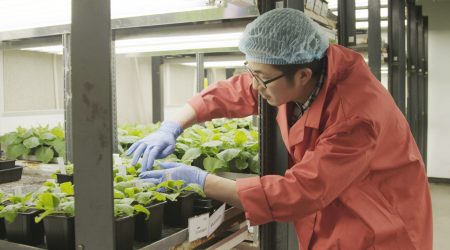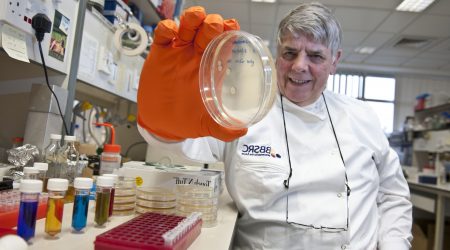A round-up of recent research from the John Innes Centre
Landmark discovery turns marathon of evolution into a sprint
A new way of rapidly generating medically significant natural products uses “Accelerated Evolution”.
A team including Isomerase Therapeutics Ltd, the University of Cambridge, Pfizer, Roche and DSTL inadvertently mimicked a process in bacteria that promotes the evolution of natural product biosynthesis. The team aimed to produce a new version of rapamycin, used to treat cancers and prevent organ transplant rejection.
This involved inserting a temperature sensitive replicon into the genes encoding rapamycin biosynthesis in the soil bacterium Streptomyces rapamycinicus. This introduced a genetic instability that activated the host’s DNA repair process, making it “spit out” the replicon from the genome, along with varying amounts of the rapamycin biosynthetic genes. The resulting offspring produced rapamycin-like molecules.
Now the team plan to harness the Accelerated Evolution platform to generate “libraries” of new and potentially useful compounds.
Plants use calcium to convey internal warning of attacking aphids
Aphids are a major pest, not only directly damaging plants but also acting as a vector, spreading damaging plant viruses.
Professors Saskia Hogenhout and Dale Sanders have discovered how plants send internal warning signals in response to attack by aphids. They found that when an insect feeds on a leaf, it triggers the plant to admit calcium into the damaged cells. This small transport of calcium prompts the plant to signal that an attack is underway, and a larger amount of calcium is then mobilised from within the cell, initiating a localised defence response. Calcium ions increase in plant cells in response to environmental changes.
Before this study, the role of calcium in responding to specific biotic interactions, such as aphid feeding, was unclear. The team used electrophysiological monitoring and a fluorescent reporter of calcium to reveal small elevations in plant calcium around initial-penetration sites. Combining these results with an evaluation of the genetic response, it was revealed that the elevation of calcium was dependent on the activity of specific cell membrane channels.
“Understanding the plant mechanisms involved in recognising the early stages of aphid feeding may provide information on how to stop the aphid in its tracks and prevent virus transmission,” said Professor Hogenhout.
Changing of the guard: research sheds light on how plants breathe
A team led by Professor Richard Morris at the John Innes Centre and including partners from The Sainsbury Laboratory and the University of Madrid has developed the first-ever complete 3D model of a guard cell.
Guard cells control the opening of stomata – tiny pores which plants use for gas exchange, water regulation and pathogen defence. Previous explanations of how stomata function have focused primarily on the characteristic thickening of the inner walls of guard cells, allowing the cells to balloon outwards as internal pressure increases. Using a 3D simulation, the new research reveals the importance of three distinct characteristics that allow guard cells to function: internal pressure of the cells, elasticity of the cell walls and their kidney-shaped geometry.
Additional work with the University of Sheffield and the Sainsbury Laboratory in Cambridge using atomic force microscopy and computer modelling revealed a stiffening in guard cell poles. Polar stiffening reflects a mechanical pinning down of the guard cell ends which prevents stomata lengthening as they open. This leads to more efficient stomal opening.
These new insights could provide important clues for improving the resilience of crops to climate change.
Green revolution genes promise additional yield
New research from Professor Robert Sablowski’s team at the John Innes Centre has revealed that mutations selected during previous breeding for shorter stems can inadvertently result in crops with fewer flowers and seeds.
High-yielding semi-dwarf varieties of cereals were developed during the Green Revolution when plant breeders selected for individuals that were short-stemmed. Plants that have shorter stems are less likely to fall over in the field, and as a result greater yields are harvested. When choosing shorter-stemmed individuals, breeders selected for variations in DELLA proteins.
The team has now shown that the same DELLA mutations that cause shorter stems also reduce the size of the inflorescence meristem. The inflorescence meristem develops into the flowers, which in turn produce seeds, and therefore its size is a key factor in crop yield potential.
The new research also demonstrates how the negative effects of DELLA mutations on meristem size can be separated from the positive effects on plant height by additional mutations.
Professor Sablowski said, “By separating the stem growth and meristem size effects, we could unlock further yield increases in widely used varieties.” This breakthrough exemplifies a way to mitigate the negative impacts brought about by trait trade-offs, potentially improving crop yields








